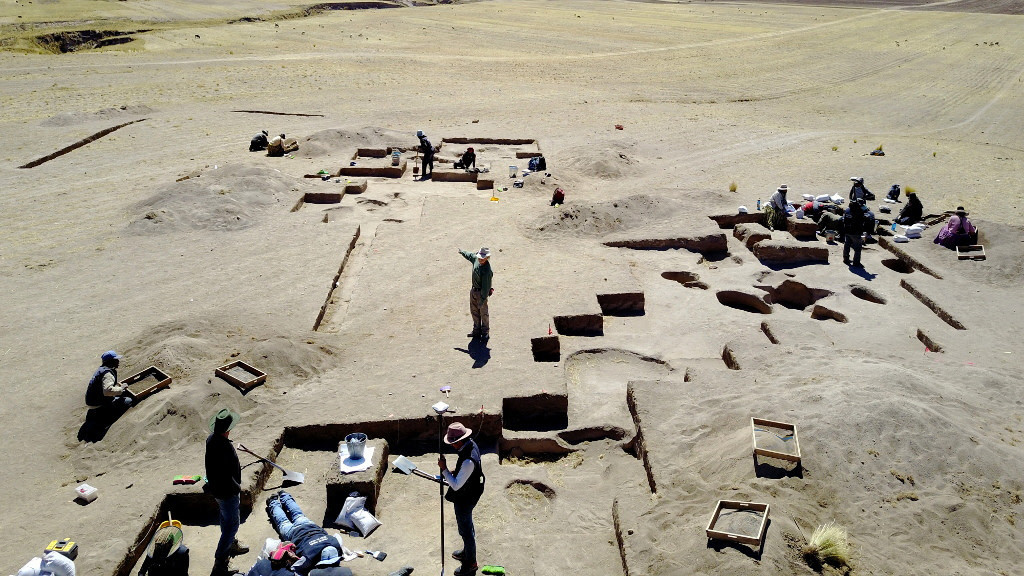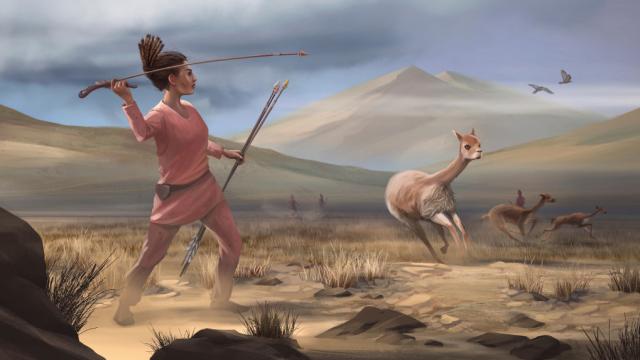Conventional thinking in anthropology has it that prehistoric hunting was an activity reserved for males, while females did the gathering. Turns out this assumption is wrong, according to a provocative new study.
She died young, somewhere between the ages of 17 and 19. Buried some 9,000 years ago in the Andean highlands of South America, the woman was laid carefully to rest, her grave goods consisting of stone projectile points and animal processing tools.
In other words, a big-game hunting toolkit.
That the woman was buried alongside hunter’s gear is a strong indication that she was a big-game hunter, according to new research published today in Science Advances. Not stopping there, the authors of the paper, led by anthropologist Randall Haas from the University of California-Davis, performed a subsequent review of the archaeological literature to see if similar examples existed. Sure enough, they found a batch of cases in which women were buried alongside big-game hunting gear.

Accordingly, the new research is throwing preconceived notions about prehistoric gender roles into doubt, showing that hunting was a more gender-neutral activity than is typically assumed. As the authors point out, it’s a classic case of sexism in the sciences.
“Our findings have made me rethink the most basic organizational structure of ancient hunter-gatherer groups, and human groups more generally,” explained Haas in a Science Advances press release. “Among historic and contemporary hunter-gatherers, it is almost always the case that males are the hunters and females are the gatherers. Because of this — and likely because of sexist assumptions about division of labour in western society — archaeological findings of females with hunting tools just didn’t fit prevailing worldviews. It took a strong case to help us recognise that the archaeological pattern indicated actual female hunting behaviour.”
The woman’s grave, along with 26 others, was found at the Wilamaya Patjxa site in Peru. The authors described the preservation of her remains as “poor,” but they were able to recover parts of her skull, teeth, and leg bones. A total of 24 stone artifacts and six projectile points were found next to the woman’s skeletal remains. As the authors note, 20 of the artifacts were “tightly concentrated and partially stacked in a pile” just above a thigh bone, suggesting the items were deliberately laid down as grave goods.
A second individual, a male between the ages of 25 and 30, was also found buried next to hunter’s gear. The discovery of these two is notable, as they now represent the earliest-known hunter burials in the Americas.
Radiocarbon dating showed that the people buried at Wilamaya Patjxa lived around 9,000 years ago during the Early Holocene. Dental analysis, along with an analysis of bone structure, confirmed the ages of death and sex of the individuals. An isotopic analysis showed the two were meat eaters, reinforcing their suspected role as hunters.

The stone projectile points were likely used to take down large animals, while the stone knives and flakes would have been used for removing internal organs and scraping and tanning hides.
Essentially, the authors are saying this woman was buried along with her stuff, which is a wholly reasonable assumption. Grave goods are strongly associated with an interred person’s societal status and role. Warriors, for example, are often buried with their swords and shields. And in fact, this exact association was recently used to show that some Viking warriors were women.
Not content to stop at Wilamaya Patjxa, Haas and his colleagues dove into the archaeological record to see if they could find similar examples. The team reviewed 429 accounts of burials from 107 sites in North and South America dating back to the Late Pleistocene and Early Holocene. In total, they found 27 unambiguous examples of people buried with their hunting gear, of which 16 were male and 11 were female.
[referenced id=”1064062″ url=”https://gizmodo.com.au/2017/09/genetic-analysis-offers-first-strong-evidence-of-female-viking-warriors/” thumb=”https://gizmodo.com.au/wp-content/uploads/2017/09/12/lqwronowzsezvn89xowm-300×165.png” title=”Genetic Analysis Offers First Strong Evidence Of Female Viking Warriors” excerpt=”Stories and poems from the Medieval era contain accounts of fearsome female Viking warriors, yet historians and anthropologists have argued that such accounts are based in myth. A DNA analysis of a 10th century skeleton found in an iconic Swedish Viking Age grave suggests there’s some truth to these old…”]
“The sample is sufficient to warrant the conclusion that female participation in early big-game hunting was likely nontrivial — greater than the trace levels of participation observed among ethnographic hunter-gatherers and contemporary societies,” wrote the authors.
Clearly, archaeologists in the past were aware of these burials, but they dismissed the possibility of these women as being big-game hunters. Because sexism. Or, as the authors put it, “modern gender constructs often do not reflect past ones,” with scientists making “uncritical assumptions about past gender roles.”
What’s more, the authors contend that prehistoric societies with a dependence on big-game hunting would have welcomed “broad participation from both females and males.”
Indeed, while we should avoid rosey depictions of the past, it’s very possible that the sexual division of labour was more equitable in the past, at least in some cultures. The team would now like to dive deeper into this topic and study how gender roles changed over time in prehistoric societies.
